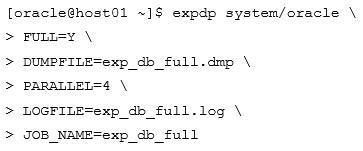You execute this command:

During the export operation, you detach from the job by using CTRL+C and then execute this command: Export> STOP_JOB=immediate
Are you sure you wish to stop the job ([yes]/no): yes
Which two statements are true about the job? (Choose two.)
- You can no longer monitor it
- You can reattach to it and monitor it
- It is paused and can be resumed
- It continues to run in the background
- It terminates
Answer(s): A,E
Reference:
https://blog.oracle48.nl/killing-and-resuming-datapump-expdp-and-impdp-jobs/